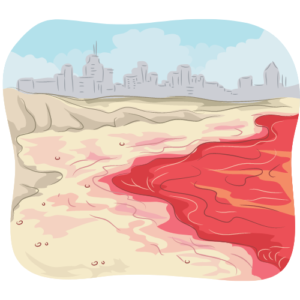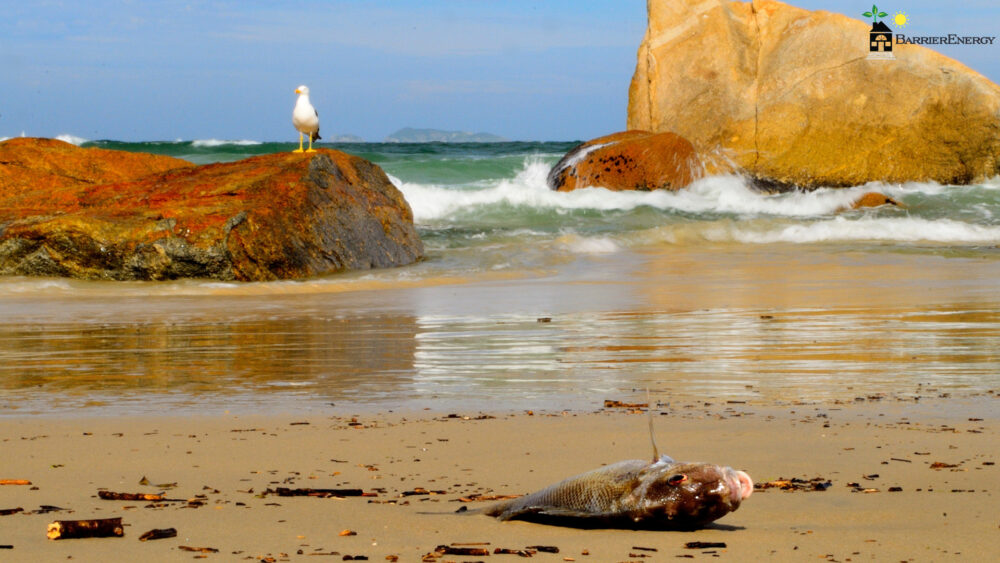California Red Tide is Increasing along Coastline:
If you’ve ever seen the effects of red tide in person, then you know this growing phenomenon is no joke. After a red algae bloom (phytoplankton), ocean water becomes oxygen-deprived and toxic. Consequently, marine life dies and either washes ashore or floats to the surface. What’s worse, harmful algal blooms (HABs) are toxic and even deadly to humans. Direct contact with polluted water or airborne particulate causes respiratory issues and skin infections. The flesh-eating bacteria that thrive in these ‘Dead Zones’ can enter the body through orifices or open wounds. Eating contaminated shellfish is poisonous to both animals and humans, alike. It sounds like something out of a horror movie, except its not fiction.
Historically, red tides appear seasonally as part of the earth’s natural cycle. Although it’s called ‘red tide’, the water color may appear completely the same during a HAB because there are varying concentrations of algae. Red algae blooms between August and December, mostly throughout the Gulf of Mexico. While a few weeks of red tide may be considered normal, we are now witnessing red tide occur more frequently and with greater severity.
Nature vs Nurture
Red algae blooms in California typically occur sporadically between spring and summer for about 1-2 weeks at a time. In the past, they haven’t had much effect because of low concentrations that don’t often reach the shore. However, recent outbreaks have been more severe. In 2020 red tide hit San Diego hard for nearly seven weeks straight, making it the worst bloom recorded in that area. Again in 2022, that record was broken by San Fransisco.
Our human impact on red tide cannot be denied. Red algae requires a combination of warm temperatures and nutrient particulate in order to thrive. Human-made structures that restrict and regulate the flow of water have a direct influence on HABs. To make matters worse, sewage and waste in San Fran are too often dumped straight into the water. Not only is this blatantly harmful to human health, but it’s costing money too. The perpetrators may think they’re saving a buck by dumping into the water, but in turn, the tourism and marine industries are suffering millions of dollars in losses.
‘Wildfire in the Water’ 
Due to pollution, bacteria in the water are present in abundance. As ocean temperatures rise in tandem, conditions are supreme for red algae outbreaks. Decade-old Sturgeon, stingrays, leopard sharks, and mollusks turned up dead all along the Bay Area in 2022. Scientists are likening this abnormality to hacking into a forest of Redwoods with a chainsaw. According to High Country News, a senior scientist at San Francisco Bay keeper called it “a wildfire in the water”. They fear that Sturgeon and other species found in the Bay Area may go extinct altogether.
As red tide increases in intensity, its impact seems to be steadily gaining territory. Once it started in the 60-mile stretch of San Fransisco Bay, it spread to San Pablo Bay and Napa County. It’s not entirely unjustified to say that we can expect to see red tide increase in intensity further south on the coastline as well. Los Angeles, for example, has been a prime location for HABs to catch hold. Even considerably ‘safer’ areas such as San Luis Obispo County, Santa Barbara County, and Ventura County are beginning to experience blooms more frequently. In August of 2022, the U.S. National Oceanic and Atmospheric Administration published an article stating that volunteer responders are getting about one hundred calls of sick or dead sea lions daily. In one case, an erratic sea lion died from Neurotoxic Shellfish Poisoning on a crowded beach by Ventura Pier.
Taking Precaution 
If Amnesic Shellfish Poisoning can take out six hundred-pound sea lions, then imagine what could happen to seafood-loving Californians. Not to mention, California is a haven for avid surfers who love to spend hours in the ocean. Always check the local news for accurate updates on red algae mapping, before you decide to take a trip to the beach. Even sunbathing during a flare-up would be unpleasant due to the stench and the threat of stepping on sharp or poisonous sea creatures. Furthermore, red tide becomes airborne when waves break. Wind can carry the toxins as far as miles inland. Inhaled toxins then cause coughing, headaches, dizziness, nausea, and even neurological symptoms; all of which correspond with Neurotoxic Shellfish Poisoning. Be on the lookout for these symptoms and leave immediately if you feel that you are in need of medical attention.
Experts are also warning to maintain a safe distance from sea lions, which can become very dangerous when suffering from neurosis. Symptoms of poisoned animals include seizures, paralysis, spastic movement, foaming at the mouth, and bulging eyes. Report any sightings to local authorities so that they can handle the situation.
Looking Ahead
Clearly, we must take direct action to combat the devastating rise of the red algae pandemic. To do nothing is to accept the beginning of the end. Without sea life, which life on earth evolved from, the whole food chain would be disrupted. What’s worse is to see a beautiful place you once loved turn into a wasteland. I personally got to witness the gradual increase in red tide throughout Florida over the years. It is destroying the beaches I once remembered so fondly. Red tide used to have a quick season in the heat of summer, but it seems now to be a year-round occurrence. My heart goes out to these local Florida communities because I see how much it hurts the people living there and the economy at the same time. All the while, the politicians using our tax money do little about it. They don’t see solving environmental issues as an investment in the community, they only see whichever lobbyist is the highest bidder. It would break my heart to see this happen to California too. Spending my summers on pristine California beaches is a fond childhood memory of mine.
However, this article is not about hopelessness; quite the contrary. The first step to solving any problem is to recognize there is a problem. We can speak up before red tide becomes a plague in California. Start making an impact by reaching out to your local and state politicians urging them about the matters important to you. They need to know where the people want the money distributed so they can accurately represent their jurisdictions. Urge them to protect the environment through legislation that promotes more research and development into the red tide pandemic. California Water Boards are attempting to investigate the cause of red tide in San Fransisco, but they are not turning up with any definitive answers. Unfortunately, everyone seems to be shrugging their shoulders as if it were some impossible mystery. Truth is that many times, the solution involves greater regulation of businesses which politicians are reluctant to do. If you have an idea about the causes of red tide in your area, be sure to include that in any letters or emails to politicians.
Meet the Author
I hope you enjoyed this article! Interested in reading more? Check out our blog post about the effects of climate change on California’s Coastline. And don’t forget to subscribe to our blog for more thought-provoking content!



Recent Comments